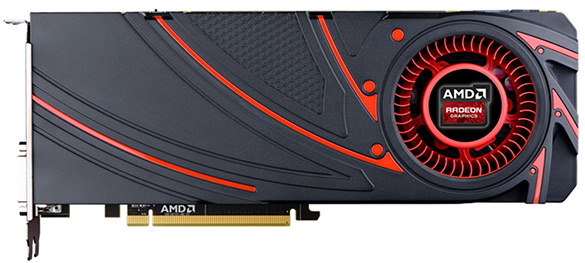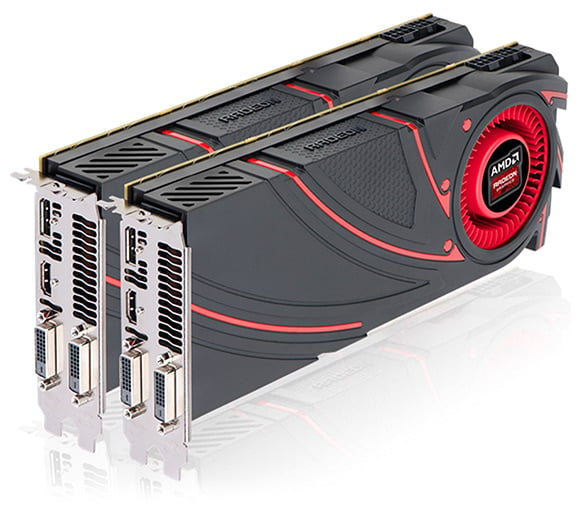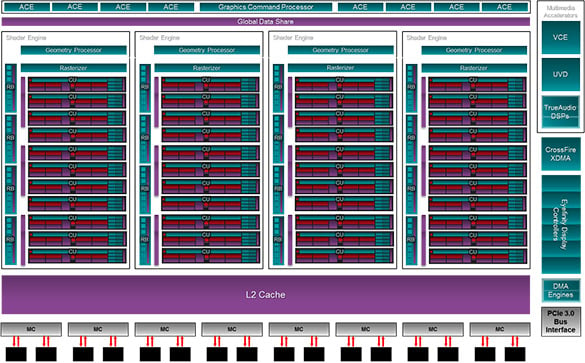AMD Radeon R9 290 Review: Hawaii Just Got Cheaper
Introduction and Specifications
Today AMD is officially releasing the Radeon R9 290. This card was originally slated to do battle with the GeForce GTX 770, but due to NVIDIA’s price cuts, AMD decided to move the R9 290 upmarket at the 11th hour. Instead, thanks to a few tweaks that came via a last minute driver drop that improves performance, the Radeon R9 290 is poised to take on the $499 GeForce GTX 780. We’ll wait to tell you how that battle shakes out until after you’ve seen all of the numbers and digested all of the specs, but as you may expect, the R9 290 comes in at a significantly lower price point than the GTX 780, which makes the head-to-head comparison much more interesting.

The AMD Radeon R9 290 Reference Board
|

As you probably deduced from its model number, the Radeon R9 290 drops in between the more affordable Radeon R9 280X and AMD's flagship, single-GPU powered card, the Radeon R9 290X. In actuality though, the Radeon R9 290 is the same card as the 290X with a few blocks in its GPU disabled and a slightly lower, peak GPU frequency. The two cards are built around the same GPU (codenamed Hawaii) and they feature the same memory interface, memory frequency, and 4GB frame buffer.

Radeon R9 290 CrossFire -- Dongles No Longer Required
As you can see in the specification table above, the Radeon R9 290 features 2560 Stream Processors (down from 2816 in the 290X) and an engine clock of up to 947MHz (down from 1GHz on the 290X). It says “up to” instead of a firm number because of some changes made to AMD’s PowerTune technology, which dynamically adjust the GPU frequency based on the chip's temperature. More details on the latest AMD PowerTune technology employed in the Radeon R9 290 and 290X is available in this article. The card’s 4GB of GDDR5 memory is connected to the GPU via a wide 512-bit interface and R290 requires a pair of supplemental power connectors—one 6-pin and one 8-pin.
As we've mentioned, the Radeon R9 290 is based on the GPU codenamed Hawaii. While it is a new GPU design in AMD’s line-up, it is still based on the Graphics Core Next architecture (GCN), which debuted in the Radeon HD 7000 series. The GPU has been significantly beefed up versus previous-gen products, however, and is one of the largest pieces of silicon to come out of AMD in quite a while.
The R9 290 series GPU (Hawaii) is comprised of up to 44 compute units with a total of 2,816 IEEE-2008 compliant shaders, 176 texture unit, and 64 ROPs. The GPU has four geometry processors (2x the Radeon HD 7970) and can output 64 pixels per clock. The GPU also has 1MB of L2 cache on board and features a wide 512-bit GDDR5 memory interface, versus the 384-bit interface on AMD’s previous-gen high-end parts. The R9 290 series GPU features roughly 6.2 billion transistors and is manufactured using TSMC’s 28nm processor node. Its die size is about 438mm2, which is approximately 24% larger than the Radeon HD 7970 (Tahiti) which came in around 352mm2. Unlike the R9 290X, however, the R9 290 has 4 CUs disabled in the GPU, which brings the stream processor count and number of texture units down to 2560 and 160, respectively.
AMD Radeon R9 290 Reference Card
Though it is not a complete departure from older models, the new AMD Radeon R9 290 has a fresh new look versus previous-generation Radeon HD series cards, thanks to its newly designed cooling shroud which features a textured top and wide ridges that run the length of the shroud and swoop into the fan intake.
Just like the Radeon R9 290X, the new Radeon R9 290 is roughly 11” long and two-slots wide, but there are a number of small enhancements on the 290 which aid in cooling the card, especially if multiple cards are installed in adjacent slots. In addition to the aforementioned notches cut into the shroud, there are a trio of holes at the rear to help exhaust air from the card. There are also vents cut into the top near the mounting bracket and there’s a deep slope on the rear. All of these little things mean more air can get to the 290’s cooling fan and that heated air is more easily expelled from the heatsink assembly.
It’s important to mention the R9 290’s cooling configuration because the card runs quite hot. By default, AMD sets the PowerTune max temperature to 95’C, which is about 15’C hotter than a GeForce GTX Titan. AMD claims running the GPU at that temperature poses no long-term threat, though obviously time will tell.
As we’ve mentioned, the Radeon R9 290 sports a “Hawaii” GPU, with 2560 Stream Processors, 160 texture units, and an engine clock of up to 947MHz. At that speed, the card is capable of up to 4.9 TFLOPS of compute performance and a 152 GTexel/s texture fill rate. The Radeon R9 290’s pixel fillrate is 64Gpixels/s. The Radeon R9 290 also features a 512-bit memory interface with 4GB of GDDR5 memory clocked at an effective data rate of 5.0Gbps, for a peak of roughly 320GB/s of memory bandwidth. All told, geometry processing, compute performance, texture and pixel fillrates, and memory bandwidth have all been increased significantly over AMD’s previous high-end GPU.
In addition to the higher performing GPU, Hawaii brings with it a number of other enhancements as well, including TrueAudio Support, bridgeless CrossFire, and a more flexible output configuration. We covered all of those new features in our coverage of the Radeon R9 290X a couple of weeks back though, so we won't go into them again here.







